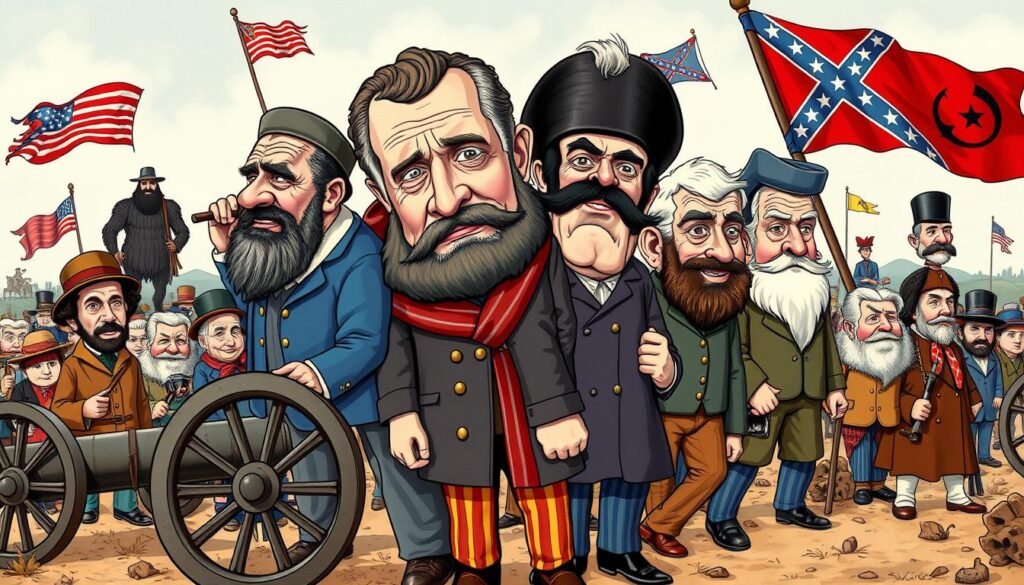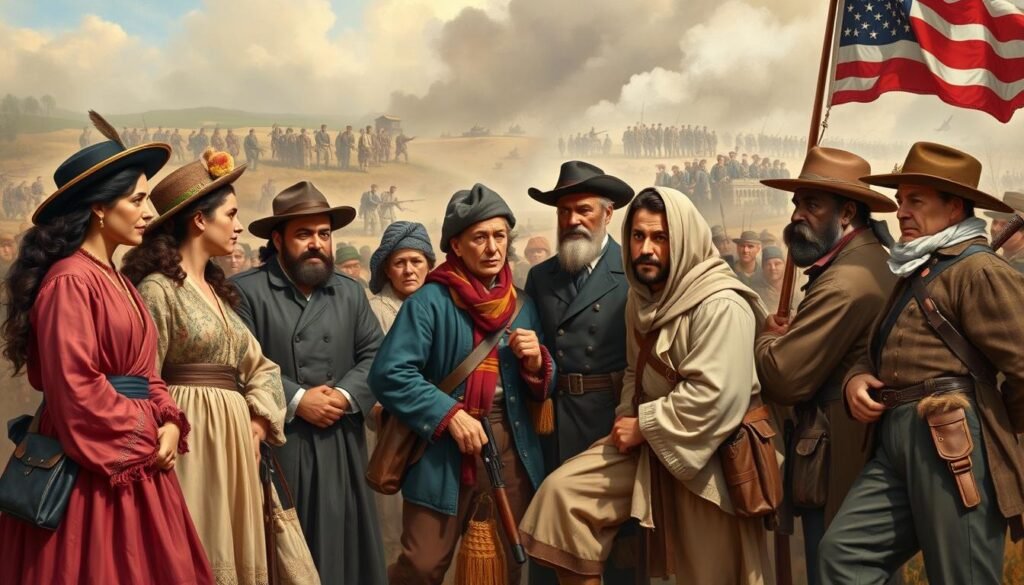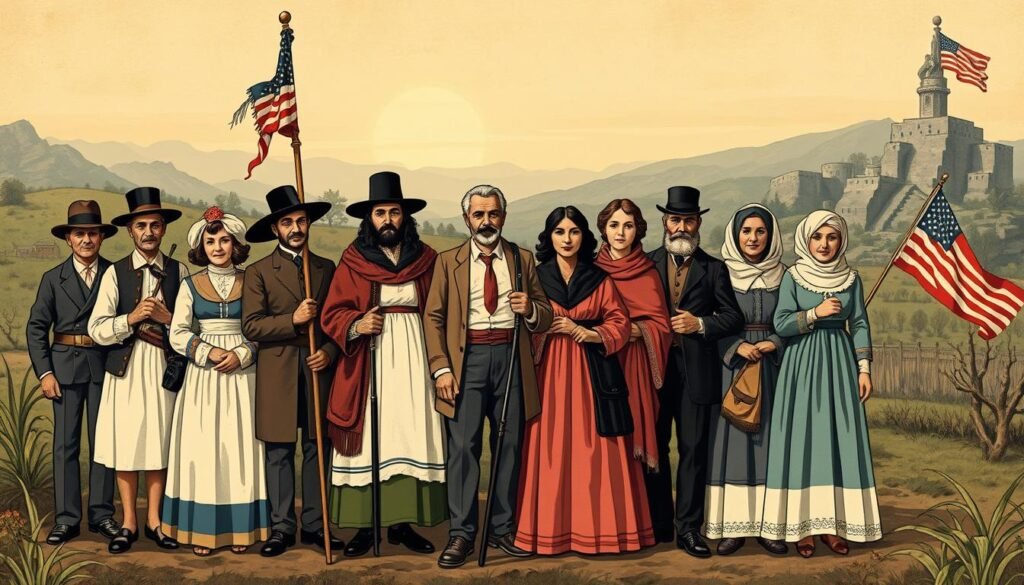Civil War Cartoons and Their Depictions of Immigrants
Thomas Nast created 2,250 cartoons over 30 years at Harper’s Weekly. These works highlight the social dynamics of the Civil War era, including how immigrants were depicted. Cartoons from this time show the tensions and biases of the era, often using images to spread negative stereotypes.
For example, Nast made 46 cartoons about Chinese immigrants. These show how views of Chinese Americans changed between 1868 and 1886.
The context of these cartoons is key to understanding the era. The Civil War saw big changes, like more Chinese immigrants coming due to the Gold Rush of 1848. By 1892, there were about 110,000 Chinese in the U.S., causing labor competition and anti-Chinese feelings. Cartoons from this time greatly influenced public views on these issues.
Key Takeaways
- Civil War Cartoons and Their Depictions of Immigrants often perpetuated negative stereotypes and biases.
- Thomas Nast’s cartoons, including those about Chinese immigrants, demonstrate the complex social dynamics of the time.
- The Civil War era saw significant demographic changes, including the influx of Chinese immigrants.
- Civil War political cartoons played a critical role in shaping public opinion on immigration and labor competition.
- The historical context of these cartoons is essential in understanding the social and political climate of the time.
- Civil War Cartoons and Their Depictions of Immigrants continue to provide valuable insights into the complexities of American history.
The Rise of Political Cartoons During the Civil War Era
During the Civil War era, political cartoons became a key way to shape public opinion. They played a big role in how Americans saw immigrants. Historical cartoons about immigrants often showed them in a bad light, spreading stereotypes and anti-immigrant feelings.
Newspapers and magazines grew, giving cartoonists a place to share their work. Publications like Puck and Harper’s Weekly tackled topics like immigration and slavery. These cartoons used humor and irony to share complex ideas, making them a favorite for commenting on current events.
Some important stats show how big immigration was back then:
- More than five times as many people immigrated to the United States in 1854 compared to 1844.
- By 1860, over 13% of U.S. inhabitants were born outside the country.
These numbers show how much immigration changed American society. Political cartoons played a big part in shaping public views on this issue.
Political cartoons used images and symbols to share ideas and feelings. This made their messages clear and interesting to more people. So, Historical cartoons about immigrants give us a peek into the social and political times of the Civil War era.
Understanding the Social Climate of 19th Century Immigration
The 19th century saw a lot of tension and prejudice towards immigrants. This was shown in Civil War-era editorial cartoons. Many Americans felt immigrants threatened their way of life. Cartoons often showed Immigrant stereotypes in 19th-century cartoons.
Many immigrants came from Ireland, Germany, and China during this time. This influx fueled the negative feelings towards them.
Guides like the 1816 “Hints to Emigrants from Europe” tried to help immigrants settle. But, anti-immigrant feelings were strong. These feelings went back to the 18th century. Even Benjamin Franklin and Thomas Jefferson worried about German immigrants.
Cartoonists like Joseph Keppler and Thomas Nast had a big impact. Keppler’s Puck magazine tackled social issues during the Grant administration. Nast’s cartoons helped shape American political cartoons in the 19th century. Their work showed how cartoons could shape public opinion on immigration.
- Between 1800 and 1900, guides for immigrants were made in a dozen languages.
- The Great Hunger drove Irish immigration, which coincided with other big waves of immigrants.
- From 1850 to 1900, Chinese immigrants faced many restrictions and prejudices in literature.
Common Stereotypes and Caricatures in Civil War Cartoons and Their Depictions of Immigrants
The Civil War era saw a lot of Ethnic representation in Civil War illustrations. These often showed immigrants in a bad light. Racial caricatures in Civil War art were also common, with immigrants being shown in exaggerated ways.
Irish Americans were often seen as violent and drunk in these cartoons. German Americans were shown as clumsy and not very smart. These images were meant to make immigrants look bad.
Irish American Representations
Irish Americans were often shown as violent and drunk in Civil War cartoons. This was because of the anti-Irish feelings of the time. For example, Thomas Nast’s cartoon “The Usual Irish Way of Doing Things” shows an Irishman in a negative light.
German American Portrayals
German Americans were also shown poorly in Civil War cartoons. They were often seen as clumsy and not very capable. These images were used to spread negative ideas about immigrants.
Other groups, like Chinese immigrants, were also shown in a bad light. These stereotypes and caricatures show the prejudices of the time. They remind us of the need to understand the historical context of Racial caricatures in Civil War art.
Artistic Techniques Used to Convey Prejudice
Civil War Cartoons and Their Depictions of Immigrants used clever artistic tricks to show prejudice. They used caricature and exaggeration to make negative stereotypes clear. For example, Irish immigrants were shown with big, exaggerated faces to make them seem bad.
These cartoons also used visual elements like images and symbols to share complex ideas. They helped create a clear divide between different immigrant groups. This made their messages strong and lasting.
Some notable trends in these cartoons include:
- The first caricatured group in the 1840s: Irish immigrants
- Subsequent caricatured groups included African Americans, Jews, Germans, Chinese, and Italians by the turn of the century
- Racial and ethnic characteristics depicted using exaggerated and derogatory stereotypes
These artistic methods greatly influenced how people thought about different immigrant groups during the Civil War. The effects of these cartoons are felt today, reminding us of the need to fight prejudice in all its forms.
Looking into the artistic techniques of Civil War Cartoons and Their Depictions of Immigrants helps us understand history better. It shows how art was used to spread prejudice. This knowledge helps us deal with prejudice today and strive for a more welcoming society.
Northern vs Southern Perspectives on Immigration in Political Cartoons
The Immigrant portrayal in Civil War cartoons showed big differences between the North and South. This is clear in the Historical cartoons about immigrants found in Union and Confederate papers.
In the North, cartoons saw immigrants as a good addition to the workforce. In the South, they were seen as a danger to the social order. Cartoons were a big part of the political talk back then.
Some main differences in Immigrant portrayal in Civil War cartoons are:
- Union papers highlighted immigration’s economic benefits, while Confederate ones talked about social and cultural dangers.
- Northern cartoons showed immigrants as hardworking, while Southern ones called them lazy and needing government help.
- The Historical cartoons about immigrants in the North pushed for their rights and inclusion. In the South, they pushed for keeping them out.
These differences in Immigrant portrayal in Civil War cartoons show the big social and economic gaps between the North and South. They also show how Historical cartoons about immigrants helped shape opinions on immigration.
| Publication | Perspective on Immigration |
|---|---|
| Union Publications | Economic benefits, immigrant rights, and inclusion |
| Confederate Publications | Social and cultural risks, exclusion, and restriction |
Famous Cartoonists and Their Influence on Public Opinion
Civil War-era editorial cartoons were key in shaping public views, focusing on immigrant stereotypes. Thomas Nast, a famous cartoonist, made a big impact. His cartoons helped sway voters in the 1864 election.
Nast’s cartoons left a lasting mark. They helped bring down Boss Tweed in 1873. His skill in using visuals to explain complex issues made him a strong voice of the time. Some of his notable works include:
- Over 140 political cartoons targeting Boss Tweed
- Cartoons that may have significantly influenced voter sentiment during the 1864 election
- Illustrations that were cited by Ulysses S. Grant as contributing to his victory in the 1868 election
Cartoonists often used immigrant stereotypes in their work. But Nast also showed the challenges faced by immigrants. His cartoons were important political commentary, reaching those who couldn’t read.
The effect of Civil War-era cartoons on public opinion was huge. Cartoonists like Thomas Nast were key in shaping views on immigrant stereotypes and politics.
| Cartoonist | Notable Works | Influence on Public Opinion |
|---|---|---|
| Thomas Nast | Over 140 political cartoons targeting Boss Tweed | Contributed to the eventual conviction of Boss Tweed in 1873 |
| Other notable artists | Variety of cartoons and illustrations | Helped shape public opinion on immigrant stereotypes and political issues |
The Impact of These Cartoons on Immigration Policy
Cartoons from the Civil War era had a big impact on immigration policy. Ethnic representation in Civil War illustrations often showed immigrants in a bad light. This helped shape public opinion and policy.
The Chinese Exclusion Act of 1882, for example, was influenced by these cartoons. It banned Chinese immigration for ten years. The act was based on Racial caricatures in Civil War art that saw Chinese immigrants as a threat.
These cartoons were used as propaganda. They showed negative views of immigrants. Racial caricatures in Civil War art played a big role in this, using visuals to spread biases.
The Chinese Exclusion Act was the first federal law to limit immigration by nationality. It shows how cartoons influenced policy.
Today, we can see the lasting impact of these cartoons. Debates on immigration policy are ongoing. Looking at these cartoons helps us understand the complex history of immigration in the U.S.
| Law | Year | Impact |
|---|---|---|
| Chinese Exclusion Act | 1882 | Prohibited Chinese immigration for ten years |
| Immigration Act of 1917 | 1917 | Restricted immigration from certain countries, including China and India |
Cultural Legacy and Modern Interpretation
The cultural legacy of Civil War-era cartoons is complex and multifaceted. These cartoons have been studied and discussed a lot. Thanks to digital archives, we can now explore them in new ways.
Keeping these historical documents safe is key to understanding the past. Many groups are working hard to preserve these important pieces. Cartoons from the Civil War offer a unique look into the era’s politics and society.
Some important parts of the cultural legacy of Civil War cartoons include:
- Today, we use digital tools to study and understand these cartoons.
- Efforts to save these cartoons and related documents are ongoing.
- Teachers use these cartoons to teach students about history and culture.
Today, many cartoonists find inspiration in the works of Thomas Nast and others from that time. By studying these cartoons, we learn more about the past. We also see how it shapes our world today.
| Cartoonist | Number of Cartoons | Notable Works |
|---|---|---|
| Thomas Nast | Approximately 2,250 | Cartoons focused on Chinese immigrants, Chinese Americans, and China-U.S. relations |
Lessons for Modern Political Discourse
Looking at Immigrant portrayal in Civil War cartoons teaches us a lot about visual media’s power. It shows how stereotypes and biases are spread and fought. Visuals are key in today’s politics, used by artists and media to share messages.
Thomas Nast’s cartoons, for example, greatly influenced public views and policies. His work on Immigrant portrayal in Civil War cartoons helped spark discussions on freedom, rights, and immigration. George Frederick Keller’s cartoons also show how images can reinforce negative views.
Important lessons for today’s politics include:
- It’s vital to think critically about what we see and hear, looking at different views.
- We must challenge stereotypes and biases in all media.
- Visuals are powerful in sharing complex ideas and feelings.
By learning from history, we can build a fairer society. Studying Historical cartoons about immigrants helps us understand how images have shaped opinions and policies over time.
Conclusion: Understanding Historical Prejudice Through Political Art
Looking at Civil War-era gives us a deep look into old prejudices. These show the tensions around immigrant groups. They offer a visual history of the era’s complex views.
Artists like Thomas Nast used images to share big ideas. They often used stereotypes and caricatures to influence people. While some cartoons showed kindness to minority groups, many were mean. This shows how deep prejudices were in American society.
By examining these , we learn a lot about how images have shaped views on immigrants. This history teaches us the importance of empathy and accuracy in today’s politics.
FAQ
What is the historical context and significance of Civil War-era cartoons depicting immigrants?
How did the rise of political cartoons during the Civil War era impact the depiction of immigrants?
What was the social climate surrounding 19th-century immigration, and how was it reflected in Civil War-era cartoons?
What were some of the common stereotypes and caricatures used in Civil War cartoons to depict different immigrant groups?
How did the artistic techniques used in Civil War-era cartoons contribute to the conveyance of prejudice?
How did the Northern and Southern perspectives on immigration differ in their political cartoons during the Civil War?
What was the influence of famous cartoonists like Thomas Nast on public opinion during the Civil War era?
How did the depiction of immigrants in Civil War-era cartoons influence immigration policy?
What is the cultural legacy of Civil War-era cartoons, and how can they inform modern political discourse?
Source Links
- Illustrating Chinese Exclusion
- William Boss Tweed, political machines, U.S. history, corruption, Gilded Age, political power, Tammany Hall, urban politics
- Smarthistory – Nativism and the Know-Nothing Party: American Art in Context
- “Reds” & “Americans,” America in the 1920s, Primary Sources for Teachers, America in Class, National Humanities Center
- Political Illustrations – Cartoon America | Exhibitions
- Political Cartoons, Part 3: 1850-1900 – First Amendment Museum
- Picturing US History – Irish Immigrant Stereotypes and American Racism
- The Legacy and Impact of Political Cartoons on National Identity
- Stereotypes in Cartoons | History Teaching Institute
- Immigration in U.S. History: Through the Eye of Editorial Cartoons
- The Art of Suffrage: Cartoons Reflect America’s Struggle for Equal Voting Rights | Constitutional Accountability Center
- WASP: Racism and Satire in the 19th Century
- Class Conflict in the Union and the Confederacy
- The Political Cartoonist Who Helped Lead to ‘Boss’ Tweed’s Downfall | HISTORY
- “The World of Thomas Nast”
- Herblock Looks at 1965: Fifty Years Ago in Editorial Cartoons – Herblock Gallery | Exhibitions
- Gilded Age, immigration cartoons, political satire, cultural commentary, social issues, visual analysis
- Smarthistory – Nativism, immigration, and the Know-Nothing party
- Illustrating Chinese Exclusion
- 9.1: Representing “Race”- From Emancipation to Jim Crow
- MIT Visualizing Cultures
- Teaching the Reconstruction Era Through Political Cartoons – The Journal of the Civil War Era
























